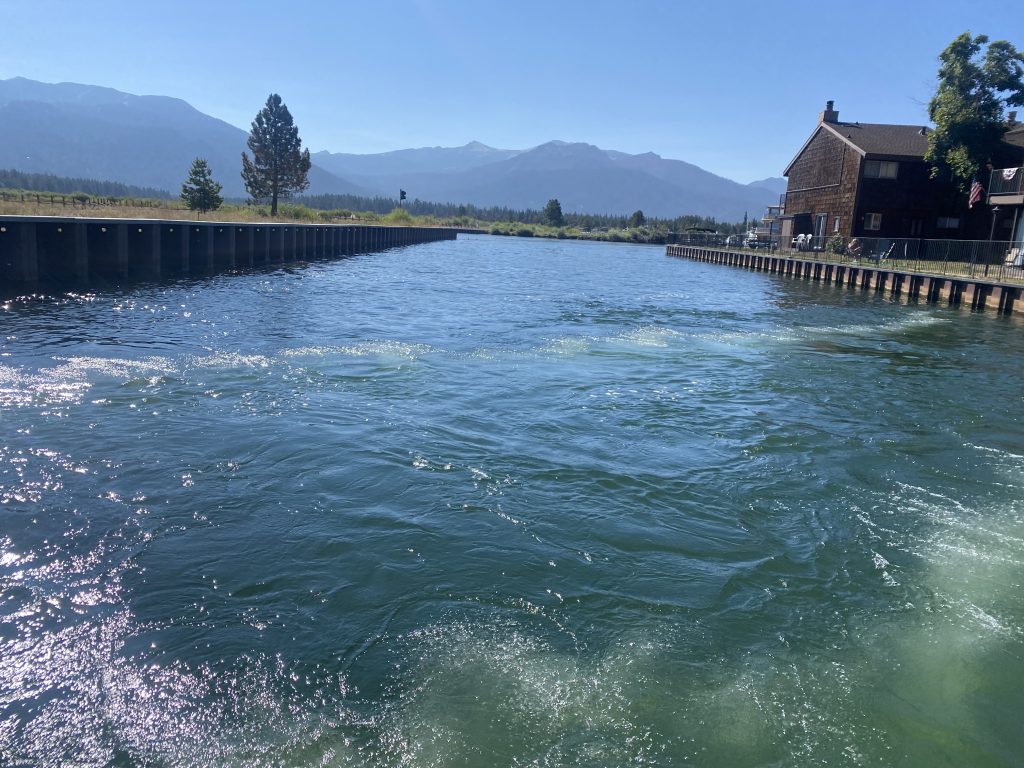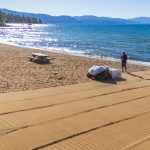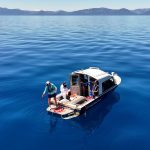Tahoe Keys Control Methods Test finds integration of multiple methods key
SOUTH LAKE TAHOE, Calif. – Partners are working on a long-term management plan for the aquatic invasive plants in the Tahoe Keys after the conclusion of a three-year control methods test points to an integrated approach as key. Project partners, including the Tahoe Regional Planning Agency, and the Tahoe Keys Property Owners Association, presented test findings to the Lahontan Regional Water Board on Thursday, Aug. 28.
“It’s clear that not one method is going to be the silver bullet for this problem,” said Lars Anderson, PhD, science consultant for the Tahoe Keys Property Owners Association, explaining the most important finding is that multiple methods need to be carefully applied and integrated for optimal control.
Aquatic invasive plants have proliferated in the Tahoe Keys Lagoons despite the property owners association’s control attempts since the mid-1980s. It is the largest aquatic invasive plant infestation in the region. A survey revealed that approximately 85-90% of the available wet surface in the lagoons were infested with the weeds, threatening to spread to other areas of the lake.
“Basin partners understood that this is just not a Tahoe Keys problem, but a lake-wide problem,” TRPA’s Aquatic Invasive Species Program manager, Dennis Zabaglo, said.
The methods used up until the test had been non-chemical, as required by the Lahontan Water Board and TRPA. The water board and TRPA authorized the one-time application of aquatic herbicides in the control methods test, which proposed to evaluate multiple treatment methods, such as the chemical/herbicides, as well as non-chemical, and the combination of both, starting in 2022 and concluding in 2024.
Test results
Results indicated that an integrated approach is necessary, as certain methods only worked in the middle of the lagoons, while others were more effective near the shore. One example is the ultraviolet (UV) method, which was not successful in the shoreline areas due to the structures in those regions, but had success mid-channel.
The test divided treatment methodologies into two groups. Group A included herbicides and UV in the first year, followed by non-chemical methods. Group B used non-chemical methods alone, including UV in spot treatments. Results were evaluated against a standard of reducing weed abundance by 75%. That standard was determined to be what was likely feasible to maintain over the long term.
Group A results:
- Herbicides: 60-75% reduction in mid-channel
- UV/Herbicide combination: 60-75% reduction mid-channel
- UV only: 75% reduction mid-channel areas only in years 2 and 3
- UV-near shore: no practical and effective use for near shore areas
- Laminar flow aeration (LFA): no reduction
Group B results:
- UV spot treatments: 75% reduction mid-channel with three repeat treatments and best in large areas
- Bottom barriers: 95% reductions while in place, regrowth after removal
- Post-barrier treatments: 50-65% reduction
- Diver assisted suction: 75% reduction
Double turbidity bubble curtains were a required protective measure in the Lahontan and TRPA permits, and proved effective at preventing herbicide movement outside of the Tahoe Keys.

Another promising finding was that native plant regrowth occurred with every method applied and increased in herbicide-treated sites.
Two different herbicides were used with varying effectiveness on different plants. Triclopyr was effective longterm on Eurasian water milfoil. One surprise was its effectiveness on curly leaf pondweed, which is not a labelled targeted species of the product. As expected, it was not effective on coontail.
The other herbicide, Endothall, was effective against Eurasian water milfoil, as well as curlyleaf pondweed, and coontail. Neither herbicide had negative impacts on native plant species.
Test challenges
The Control Methods Test required an extensive monitoring program with around 100 people and 12 teams over the course of implementation. With bi-weekly, weekly, and in some cases, daily sampling, it produced thousands of data points.
Test partners, including the TRPA, who provided independent oversight and monitoring, the property owners association and the League to Save Lake Tahoe, were happy to report that all methods were applied successfully and met stringent monitoring requirements; however, it wasn’t without its challenges.
At the start of the test in 2022 and one-time herbicide application, the water levels were low. In 2023 and 2024, water levels rose, which offered new non-herbicide treated habitat for the invasive plants. This is why project managers believe the efficacy of the herbicides dropped.
Bottom barriers, although effective, were not selective, killing native plants as well. It also required follow-up post-barrier treatments to prevent regrowth.
Curlyleaf pondweed proved to be an exceedingly difficult challenge due to its prolific and hardy reproductive bodies, called turions, which can live in the lakebed for many years. Test surveys found around 150,000 turions per acre. “It’s a nightmare,” Anderson said, “unless you start making some dents in the production of the turions and then they’re sprouting, you’re never going to catch up and be ahead of this problem.”
Diver assisted suction was successful in removing some curlyleaf pondweed turions. However, visibility is a challenge with the method and reduces the ability to be selective with species. Anderson proposed a twice-a-year approach to controlling curlyleaf by targeting its biomass in the spring and the sprouting turions in the fall and winter.
A path forward
Optimizing resources for improved control of curly leaf pondweed is a priority moving forward in the Tahoe Keys, in addition to the continued use of cutting-edge treatments as partners prepare a long-term aquatic invasive plant management plan for the Tahoe Keys. Anderson also highlighted improvements in the regulatory process in a future plan.
“You need to have flexibility, and you can’t wait a year to get a permit to do it every year,” he said. “It’s too late.”
The longterm management plan will work to maintain the control methods test benefits while a long-term solution is put in place, engage stakeholders, bring in new partners, and further data analysis.
The Tahoe Science Advisory Council provided independent peer review of the test and its findings.

Support Local Journalism

Support Local Journalism
Readers around the Lake Tahoe Basin and beyond make the Tahoe Tribune's work possible. Your financial contribution supports our efforts to deliver quality, locally relevant journalism.
Now more than ever, your support is critical to help us keep our community informed about the evolving coronavirus pandemic and the impact it is having locally. Every contribution, however large or small, will make a difference.
Your donation will help us continue to cover COVID-19 and our other vital local news.












